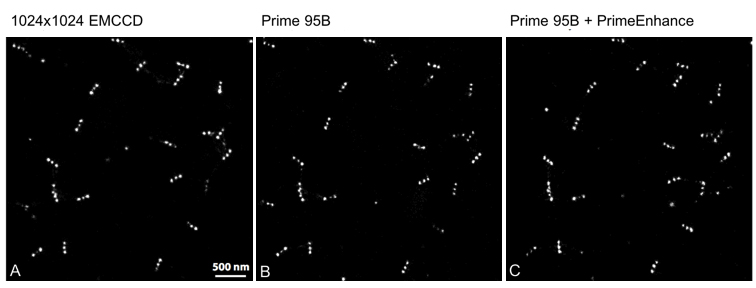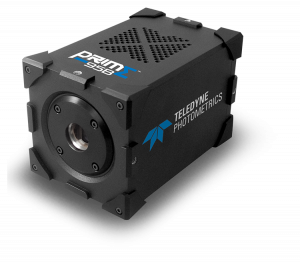Dr. Sang-Hee Shim, Principal Investigator and Assistant Professor of Chemistry
Shim Group, Center for Molecular Spectroscopy and Dynamics, Institute for Basic Science, Korea University
Background
The Shim Group at Korea University is an interdisciplinary lab covering physical chemistry, biophysics and cell biology. Sang-Hee Shim, principal investigator and assistant professor of chemistry, leads a team composed of postdoctoral researchers and graduate students to develop new microscopic methods and apply them to answer complex biophysical questions.
Their core focus is to better understand life at the molecular scale by visualizing cell dynamics and the interactions of intracellular molecules. To do so, they explore the frontiers of optical microscopy with super-resolution fluorescence imaging.

A. 1024×1024 EMCCD camera with a 130 nm effective pixel size 32×32 field. Acquired at 47 fps with 20 ms exposure, 30x EM gain. B. Prime 95B Scientific CMOS (sCMOS) camera with a 110 nm effective pixel size. Acquired at 50 fps with 20 ms exposure time. C. Prime 95B plus PrimeEnhance with a 110 nm effective pixel size. Acquired at 28 fps with 20 ms exposure time.

A. The 1024×1024 EMCCD camera shows a mean localization accuracy of 13.29 nm. B. The Prime 95B shows a mean localization accuracy of 9.25 nm. C. The Prime 95B plus PrimeEnhance shows a mean localization accuracy of 7.47 nm.
Challenge
The Shim Group previously used EMCCD technology for localization-based super-resolution fluorescence microscopy. However, although EMCCD offers better sensitivity than sCMOS technology, it suffers from excess noise generated by the process of electron multiplication. The precision and resolution of their experiments are highly dependent on the sensitivity and noise level of the camera so this presents an issue.
The group investigated potential solutions and found the Prime 95B Scientific CMOS (sCMOS) camera from Photometrics – the first and only 95 percent quantum efficient CMOS device. The camera affords comparable sensitivity to EMCCD, yet offers far higher imaging speed and a larger field of view. After testing the camera, the group also found some cases in which it produced even better spatial resolution when compared to their existing EMCCD.
For single-molecule images like in DNA-PAINT, the Prime 95B [Scientific CMOS camera] combined with PrimeEnhance allows us to conduct super-resolution imaging with higher spatial resolution than that of EMCCD technology.
Solution
The team compared the Prime 95B to their EMCCD camera using single-molecule DNA-PAINT imaging and found that the camera gave improved localization precision. This is suggested to be because the Prime 95B does not rely on electron multiplication to increase sensitivity. By removing the excess noise factor generated by the electron multiplication process, the Prime 95B Scientific CMOS can achieve a higher signal to noise ratio than an EMCCD.
The team also investigated PrimeEnhance™, the active denoising algorithm that accompanies the Prime 95B camera. They found that PrimeEnhance can amplify some noise and produced false localizations. When the localization software was optimized for PrimeEnhance, the localization precision was further improved and gave the best results among all tested conditions.
Shim explains, “For single-molecule images like in DNA-PAINT, the Prime 95B combined with PrimeEnhance allows us to conduct super-resolution imaging with higher spatial resolution than that of EMCCD technology.” Shim adds, “Plus, the Prime 95B offers the additional benefits of higher frame rate and a larger field of view.”

